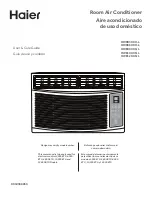
16
17
Touch Test in Heating/Cooling Cycle
The only definite indications that the slide is in the
mid-position is if all three tubes on the suction side of the
valve are hot after a few minutes of running time.
NOTE: A condition other than those illustrated above, and
on Page 28, indicate that the reversing valve is not shifting
properly. Both tubes shown as hot or cool must be the same
corresponding temperature.
Procedure For Changing Reversing
Valve:
1. Install Process Tubes. Recover refrigerant
from sealed system. PROPER HANDLING OF
RECOVERED REFRIGERANT ACCORDING TO
EPA REGULATIONS IS REQUIRED.
2. Remove solenoid coil from reversing valve. If coil is to
be reused, protect from heat while changing valve.
3. Unbraze all lines from reversing valve.
4. Clean all excess braze from all tubing so that they will
slip into fittings on new valve.
5. Remove solenoid coil from new valve.
6. Protect new valve body from heat while brazing with
plastic heat sink (ThermoTrap) or wrap valve body with
wet rag.
7. Fit all lines into new valve and braze lines into new
valve.
Reversing Valve in Heating Mode
Electrical Circuit and Coil
(Reversing valve coil is energized in the heating cycle only).
1. Set controls for heating; valve should shift if there is
pressure in the sealed system.
2.
REMOTE THERMOSTAT HEAT PUMP UNITS:
Check
for line voltage at the heat relay, terminal #4 and the
reversing valve relay terminal #4. If voltage isn't present,
test the heat relay and the reversing valve relay.
3.
STANDARD HEAT PUMP UNITS:
Check for line voltage
at system switch terminal #7 and thermostat terminal #2.
If voltage is not present, test the system switch.
Testing Coil
1. Turn off high voltage electrical power to unit.
2. Unplug line voltage lead from reversing valve coil.
3. Check for electrical continuity through the coil. If you
do not have continuity replace the coil.
4. Check from each lead of coil to the copper liquid line as
it leaves the unit or the ground lug. There should be no
continuity between either of the coil leads and ground;
if there is, coil is grounded and must be replaced.
5. If coil tests okay, reconnect the electrical leads .
6. Make sure coil has been assembled correctly.
Checking the Reversing Valve
NOTE:
You must have normal operating pressures before
the reversing valve can shift.
Check for proper refrigerant charge. Sluggish or sticky
reversing valves can sometimes be remedied by reversing
the valve several time with the airflow restricted to increase
system pressure.
To raise head pressure during the cooling season the airflow
through the outdoor coil can be restricted . During heating
the indoor air can be restricted by blocking the return air.
Dented or damaged valve body or capillary tubes can
prevent the main slide in the valve body from shifting.
If you determine this is the problem, replace the reversing
valve.
After all of the previous inspections and checks have been
made and determined correct, then perform the "Touch Test"
on the reversing valve.
Never energize the coil when
it is removed from the valve
as a coil burnout will result.
















































